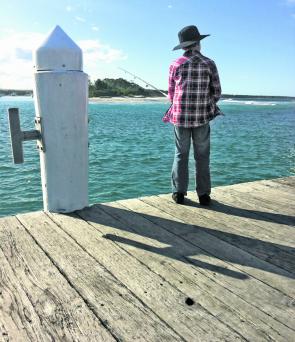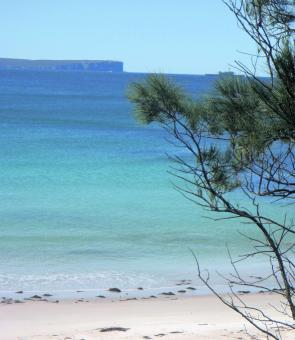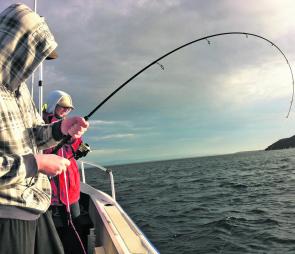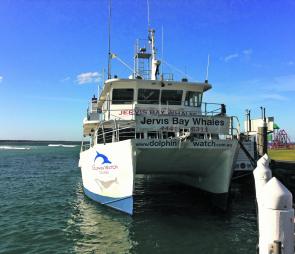For some the South Coast is often thought of as south of Sydney and Wollongong, but the real South Coast, in particular the Shoalhaven area, begins as you round the Kiama bends and pull over to take in the view from the carpark overlooking Gerringong and Werri Beach. This is where the mountains meet the sea and the start of your journey into a mixture of rural villages with community spirit bounded by a culture that loves the beach and the bush.
Less than two hours’ drive south of Sydney, Gerringong is a little gem of a village perched high on a ridge within spitting distance of a right-hand point break. It’s a great pit stop for a hungry traveller with a fine mix of cafés, boutique shopping and one of the largest surf shops in the Southern Hemisphere.
Just south of Gerringong, at the southern end on the Crookhaven Bight, the real year-round piscatorial delights begin, with the Shoalhaven River winding down to the ocean where offshore the famous Sir John Young Banks, now simply known as The Banks.
In December 1797, George Bass, sailing down the coast in an open whaleboat with six crew, discovered the mouth of a river. He disliked the entrance so much that he named it Shoals-Haven.
Six months later, Scot Alexander Berry entered the Crookhaven River in the Blanche after an attempt to enter the Shoalhaven River resulted in two men being drowned. Berry settled permanently at Coolangatta, on the north bank of the Shoalhaven, and the rest is history. Berry dug Australia’s first canal, between the Crookhaven and Shoalhaven rivers, that changed these watercourses forever.
The river was damned in the 1970s and Lake Yurrungah, or Tallowa Dam, is a large and heavily timbered impoundment stocked with trophy bass and giant carp.
My favourite form of fishing bar none is a canoe or kayak trip on the dam or the upper reaches of the river absorbing the breathtaking scenery while targeting bass in the timber. It’s a family-friendly experience and the serenity of the river minus the general population and their wakeboard madness instils a sense of connectedness to the land in an age of being too busy.
A good 2-4 kg rod with 6lb braid and 10lb leader will handle most situations. Best lures for summer are cicada patterns, poppers, crankbaits and walk-the-dog lures such as pencils. You can break your bass options down to three locations: The dam, below in the fresh, and then below Gradys Retreat in the brackish.
Recent tagging programs have indicated fish inhabit all these areas right through Summer and given the amount of fresh last summer you could even catch bass, bream and estuary perch within spitting distance of the Shoalhaven River Bridge in Nowra.
The bridge itself tends to be a fishing dividing line. Downstream is most popular for anglers targeting mulloway. They can be encountered throughout the salty part of the system but initial data from recent tagging programs clearly shows a preference for the lower reaches.
Numerous 40-50kg mulloway have been taken in the past year but the majority are 6-8kg. One 47kg fish taken by a solo angler on a soft plastic was the stand out for the year. Think creek mouths at tide changes and back eddies near rock walls as starting points.
There are numerous creeks downstream with Bomaderry and Broughton the most accessible. Both have 2wd access ramps and are a great place to start prospecting the miles of timber snags for bream, bass and estuary perch.
The main access to the river and offshore opportunities at the Banks are at Greenwell Point. A new dual-lane ramp, pontoon and big car park were constructed a few years back. Fuel, bait and takeaway food are close by, as are a great park with barbecues and picnic facilities.
The kids will enjoy fishing off the main commercial wharf next to the boat ramp, and at wide open throttle you can be fishing The Banks in under half an hour.
Much has been written about the Sir John Young Banks. Around five nautical miles north-east of the Beecroft Peninsula, near Currarong, The Banks are a series of shallow humps of around 20m quickly rising out of 80m of water inside the continental shelf .
Currarong itself now has a fantastic ocean launching facility for even the biggest trailer boats and you can be off the ramp and fishing the banks or below the cliffs in 15 minutes.
Inside the main humps are gravel beds and broken ground that is great country for reef species such as snapper and morwong. Kingfish abound year round, depending on the bait, and the main focus over the Summer is the run of small black marlin and sharks.
Gone are the days of chasing big fish from big boats; this is trailer boat billfish heaven on its day with plenty of 5m boats getting in on the action.
The preferred method these days is to slowly troll live slimy mackerel. In the height of summer the place is like a carpark with 30 or more boats within spitting distance of each other.
But The Banks is a year-round fishery provided you check the weather use your VHF or 27mHz radio to log on with Marine Rescue Shoalhaven, located at the Crookhaven Pilot House.
The weather in this part of the world is fickle and changes at the drop of a hat. Being caught with a raging current from the north and a southerly change can be hell, so be prepared and have a back-up plan, like the river or Jervis Bay, if the offshore weather is foul.
Currarong is one of those quaint little fishing villages you see in post cards. There is a caravan park and cottages and homes for holiday letting. The village is 27km off the Princes Highway and is surrounded by the natural beauty of the Jervis Bay National Park, Crown land and the Jervis Bay Marine Park.
As you continue to wander south it’s worth mentioning that the South Coast has a very different flavour to the somewhat commercialised North Coast. Unspoilt natural beauty is the area’s biggest asset. There’s no high rise by the sea, no marinas full of game boats and yachts and for the majority of the year bar Christmas and Easter, no crowds.
That doesn’t mean that you have to go without. Nowra has all the services and retail therapy required for the whole family.
McCallum’s Tackle World and Nowra Marine are your best port of call for all your fishing and boating needs.
If it’s boutique shopping and decaf lattes you hunger for then Berry, to the north, is the epicentre for all things quaint and expensive. The pubs do a great feed for all the family, along with the Hungry Duck restaurant, which serves Asian and modern Australian cuisine, is BYO and child-friendly.
Twenty thousand years ago, however, was a different story! The earth was ending an ice age and sea levels were rising. What is now the continental shelf off Jervis Bay (the locals say ‘Jurvis’) were mountain ranges to the east.
Around 7500 years ago the coastline as we know it today took its present form and the traditional landowners took up residence in this part of the world. Hundreds of Aboriginal sites have been identified right around the Shoalhaven region and even the untrained can identify the middens, the piles of shells from an easily acquired meal.
Jervis Bay is a testament to green triumph of sorts. Had plans from the 1960s to the 1990s eventuated, we could have seen the establishment of a city on the northern side, a Navy ammunition storage and wharf facilities, a petrochemical complex, a steelworks on a 6500ha site at Callala, major port facilities and, to top it all off, a nuclear power plant came within a whisker of being built at Murrays Beach in what is now the Booderee National Park!
These developments would have destroyed the Bay forever but thankfully we now retain over 50km of unspoilt coastline with beaches that have the whitest sand in the world and water where dolphins and whales.
One can only imagine the quality of the fishing prior to European settlement and even in the 1960s local fishermen could pole 3 tonnes of 20-30kg kingfish in an afternoon off Honeymoon Bay.
Unlike the establishment of other Marine Protected Areas in NSW, JB had a good consultation period, from 1998-2002. Not everyone was going to be happy with the outcome but you can’t please them all.
The upside to all the politics and extreme-green-lockout madness is that the fishing got better, a lot better, and with the combination of the removal of much of the unsustainable, destructive commercial netting effort and the establishment of the NSW recreational fishing havens, the fish were finally given a chance to go about their business and replenish the system.
So gone are the days of netting the estuaries, hauling the pilchards, dredging the scallops, trawling the bay for flathead and squid and 10 years on the place is in better shape.
JB is a year-round fishery in that crossover zone between tropical and temperate zones and at certain times of year you can catch bream, snapper, salmon, bonito, kingfish and small black marlin within 100m of each other. If there’s anywhere else in the world that that can be done then I want to hear about it!
Jervis Bay is now divided into marine park and Commonwealth waters (Booderee National Park) and rules apply, particularly in the sanctuary zones or no-take areas. Booderee also has a no jet ski or towing policy (tubes and water skiing, etc) to protect the little penguins, and no anchoring in less than 10m to protect vital seagrass habitat.
Best thing is to get a map and avoid the $500 fine for fishing where you shouldn’t. Simple.
JB is a very large body of water, 14km from end to end and nearly 10km across.
The weather in this part of the world can change at the drop of a hat and if you get caught out, your day can turn from paradise to your worst nightmare in minutes.
Westerly changes in late Winter and Spring come with no telltale line of cloud and can generate up to 2.5m waves going out of the bay! Top priority is check your weather, have a marine radio and know how log on to Marine Rescue if you’re venturing more than a few miles from help.
Have a good anchor with at least the length of your boat in chain and at least 150m of rope if you’re heading offshore and under the cliffs. You can be 50m off the cliffs and in 40m of water at times.
Consider hiring a guide or a booking an offshore fishing charter. There are only three operators in JB and weekends are usually booked well in advance. See the fact box for more info.
Catching a feed isn’t tough. Calamari are thick around the edges where there is clear water and seagrass. Drift for flatties in the middle of the bay with a paternoster rig.
Laying down a berley trail where rock meets sand (5-10m in the Bay and 25-35m offshore) works for reef fish. Fish lightly weighted floaters for best results although be prepared to catch 500,000 Port Jackson sharks over the Winter months.
Soft plastics really come into their own for reds with the 5” Gulp Jerkshad in nuclear chicken on a 1/6oz head hard to beat. The Bay has snapper year round but Winter is prime time for the bigger models.
Please consider releasing all snapper over 60cm because they are prime breeding stock and you won’t starve if you choose to let the fish breed another day.
Come Summer and Autumn the pelagics really come into their own and the kingfish have bounced back from brink following the ban on floating traps a decade ago.
The average Summer king is now 80-90cm on some reefs with fish to 40kg a real possibility. Leave the bream gear at home! Minimum 50lb braid and 80lb leader with a live slimy mackerel or yellowtail will do the job – if you can dodge the seals.
Under Point Perpendicular in 20m is the best place to start but be aware The Tubes, a world-famous land-based game fishing destination is about 400m from the point. Exercise caution and keep your distance from the rocks.
Last Summer there were at least two LBG marlin cut off by unsuspecting skippers.
Ten minutes south of Jervis Bay along the Wool Road lies St Georges Basin, perhaps the jewel in crown of accessible South Coast estuary fishing.
The Basin is also an amazing success story in terms of nature’s ability to recover from unsustainable estuary netting, following its declaration as one of 24 NSW recreational fishing havens a decade ago. The last declared commercial catch was around 119 tonnes, let alone the ‘cash crop’ and by-catch.
It took only two years to see the difference but what a difference it has made. Regular cricket-score catches of bream, whiting , snapper and flathead are now possible.
Every estuary has its peaks and troughs but the Basin is very consistent and home to some monster flathead, bream and tailor. Think Spring and Autumn for that 90cm flathead and year round for 60-70cm tailor and snapper to 3kg – in an estuary!
All we have to do as responsible anglers is put the big ones back and take only what we need for a feed and the system will take care of the rest. So do the right thing on your next visit.
The Basin has great launching facilities on the northern shores at Sanctuary Point and Basin View, and on the southern Side at Sussex Inlet.
Only experienced skippers should attempt to cross the very shallow and dangerous bar, but the reefs and headlands offshore receive little angling pressure and can be very productive.
There are three ramps to choose from at Sussex. With over 20 caravan parks and hundreds of affordable holiday homes to choose from, Sussex Inlet is still one of those great family getaways offering so much for the family and travelling angler.
South of Sussex there are myriad estuaries and creeks to explore along with some awesome offshore opportunities.
Lake Conjola is a small system with shallow access to the sea. Accommodation is at two caravan parks. To experience the lake at its best think Summer and Autumn.
The chances of encountering a mulloway are better at Conjola than at the Basin.
Further south, the area’s commercial trawlers and longliners call Ulladulla their home port and generations of commercial fishers continue the tradition.
Ulladulla has all the services and be a great place to book an offshore fishing charter. It’s also a staging point for the great estuary at Burrill Lake, another of the rec fishing havens on the South Coast.
If you’re travelling from Canberra or inland NSW you can now access the coast by the newly sealed main road 92, which links Canberra to the coast, or you can turn off the Hume Highway at Goulbourn to save 40 minutes and the winding bends of the Kangaroo Valley.
Save the Kangaroo valley as great day trip from the coast or that bush camp on a kayak trip.
The ACT is now a comfortable two-hour drive through the Morton Wilderness area. Access the Nerriga Road through Tarago, not Braidwood, but don’t tell anyone I told you that!
Facts
OTHER JB ATTRACTIONS
For non-fishing partners and families the dolphin watch cruise around the Bay and whale watching in season is a must. Jervis Bay is the Hervey Bay of the southern migration and it’s common to have up to 20 whales in the Bay in late October to November.
There is also the offshore trip in a big rigid hull inflatable with quad 350hp outboards, which will get you offshore and back with comfort and speed.
Huskisson is the gateway to the Bay for cruise booking, accommodation and meals.
The new pub, Stonegrill, Seagrass, and Wild Ginger are the main restaurants to consider and no trip to Husky is complete without feeding the giant flatties in the pond at the Lady Denman Museum.














